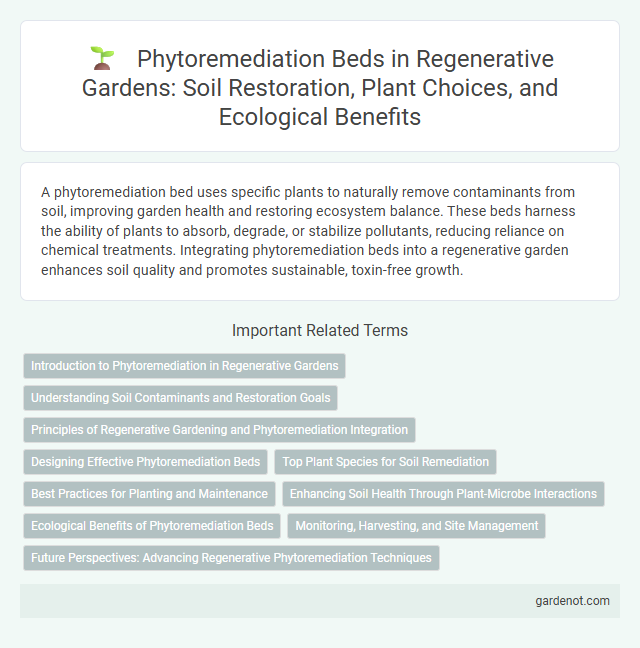A phytoremediation bed uses specific plants to naturally remove contaminants from soil, improving garden health and restoring ecosystem balance. These beds harness the ability of plants to absorb, degrade, or stabilize pollutants, reducing reliance on chemical treatments. Integrating phytoremediation beds into a regenerative garden enhances soil quality and promotes sustainable, toxin-free growth.
Introduction to Phytoremediation in Regenerative Gardens
Phytoremediation beds in regenerative gardens use specific plants to remove contaminants from soil and water, promoting ecosystem health and sustainability. These plants absorb, degrade, or stabilize pollutants such as heavy metals, pesticides, and hydrocarbons through natural processes like phytoextraction and rhizodegradation. Incorporating phytoremediation enhances soil quality, supports biodiversity, and reduces environmental toxicity without harmful chemicals.
Understanding Soil Contaminants and Restoration Goals
Phytoremediation beds utilize specific plants to absorb, degrade, or stabilize soil contaminants such as heavy metals, pesticides, and hydrocarbons, promoting soil restoration. Understanding the types and concentrations of pollutants guides the selection of appropriate hyperaccumulator species that effectively target the contaminants present. Restoration goals focus on reducing toxicity levels, improving soil health, and enabling the sustainable growth of native vegetation.
Principles of Regenerative Gardening and Phytoremediation Integration
Phytoremediation beds harness the natural ability of specific plants to absorb, degrade, and detoxify pollutants from soil, playing a crucial role in regenerative gardening practices. Integrating phytoremediation principles emphasizes soil health restoration, biodiversity enhancement, and the sustainable cycling of nutrients within garden ecosystems. This approach transforms contaminated sites into thriving habitats by promoting ecological balance and reducing the need for synthetic soil treatments.
Designing Effective Phytoremediation Beds
Designing effective phytoremediation beds requires selecting hyperaccumulator plants that target specific soil contaminants like heavy metals, pesticides, and hydrocarbons. Incorporating a layered soil profile with organic matter enhances microbial activity, improving pollutant degradation and nutrient cycling. Proper irrigation and aeration systems maintain optimal root health, maximizing the phytoremediation process in regenerative garden ecosystems.
Top Plant Species for Soil Remediation
Sunflower (Helianthus annuus) excels in phytoremediation by extracting heavy metals like lead and cadmium from contaminated soil. Indian mustard (Brassica juncea) is effective in accumulating heavy metals and breaking down organic pollutants. Vetiver grass (Chrysopogon zizanioides) stabilizes soil and absorbs toxins through its deep root system, enhancing soil health in regenerative gardens.
Best Practices for Planting and Maintenance
Selecting native hyperaccumulator plants is crucial for optimizing heavy metal uptake in phytoremediation beds. Regular soil testing guides nutrient amendments and pH adjustments, ensuring ideal conditions for contaminant absorption. Implementing seasonal pruning and removing harvested biomass prevents re-contamination and promotes sustained remediation efficiency.
Enhancing Soil Health Through Plant-Microbe Interactions
Phytoremediation beds boost soil health by leveraging plant-microbe interactions that break down contaminants and improve nutrient cycling. Specific plants like willows and poplars host beneficial microbes which enhance soil structure and promote organic matter decomposition. These natural processes increase soil fertility, supporting sustainable regenerative gardening practices.
Ecological Benefits of Phytoremediation Beds
Phytoremediation beds harness the natural ability of plants to extract, degrade, and stabilize pollutants from soil and water, significantly enhancing soil health and biodiversity. By filtering heavy metals, pesticides, and organic contaminants, these beds restore ecological balance and promote sustainable land management. Their integration supports habitat creation for beneficial microorganisms and insects, fostering a resilient and regenerative garden ecosystem.
Monitoring, Harvesting, and Site Management
Phytoremediation beds require systematic monitoring to track contaminant levels and plant health, ensuring effective pollutant absorption and soil restoration. Timely harvesting of hyperaccumulator plants prevents the re-release of toxins and maintains optimal remediation capacity. Proper site management includes soil conditioning, plant selection, and periodic assessment to sustain long-term regenerative garden productivity and environmental safety.
Future Perspectives: Advancing Regenerative Phytoremediation Techniques
Emerging regenerative phytoremediation techniques leverage genetic engineering and microbial symbiosis to enhance contaminant degradation in soil and water. Advances in remote sensing and AI-driven monitoring enable precise assessment and optimization of phytoremediation bed performance. Integrating biochar and mycorrhizal networks promises to improve pollutant uptake, fostering sustainable restoration of degraded ecosystems.
Phytoremediation bed Infographic

 gardenot.com
gardenot.com